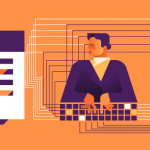
Marketing and advertising companies need to tackle new customers needs and expectations while aligning their processes and practices to new privacy requirements and technical developments.
In a data-driven world, successfully navigating between these is vital for advertisers and marketers of any size. Especially since privacy breaches can have severe consequences, ranging from reputational damage to hefty fines under data protection regulations.
Data-driven marketing means high volumes of customer data, as well as increased reliance on technology and automation. With a wave of new data protection regulations that include the EU’s GDPR, Brazil’s LGPD, and the CCPA, it’s crucial for you as a marketer or advertiser to understand your role in data protection.
What data do marketing and advertising companies need to protect?
Almost any piece of customer data you collect and store digitally is something that a cybercriminal might find valuable. It can be an email address, phone number, account information, etc. Customers also care more about the security of their data: 91% say they’re more likely to trust a brand with their information if the brand shows commitment to protecting it. If sensitive data gets leaked or stolen, you’ll have to deal with the loss of customer trust, fines, lawsuits, and more.
Besides safeguarding customer data, your marketing or advertising firm must also protect intellectual property (IP) from loss and theft. IP can be an important asset, a revenue growth opportunity, and may also create an ongoing passive revenue stream. It can include creative content such as original brand trademarks, taglines, design files, as well as technology solutions, internal processes and methods.
If you’re a marketing or advertising firm, you need to realize that data protection plays a pivotal part in the success of your business. A Data Loss Prevention (DLP) solution can help achieve this in several ways. Let’s see what the most important ones are.
1. Limit the use of removable devices
One of the biggest problems your marketing or advertising firm might be facing is the number of devices employees connect to company computers and how easily they transfer data onto these devices. USBs, in particular, have a long history of causing major data leaks and are also a popular attack vector for the infection of company networks. Although it’s tempting to block their use altogether, this can hinder your employees in their day-to-day tasks. Whether it’s large files or a way to back up their work, they might feel frustrated if they cannot copy files onto a removable drive and seek alternative file transfer solutions. This comes with a new set of security challenges.
With a DLP solution that offers Device Control possibilities, you can control the use of USBs and peripheral ports as well as Bluetooth connections. Our award-winning solution, Endpoint Protector, comes with options to block the connection of specific devices to company computers such as mobile phones, USBs, or external drives and allow access only to predefined trusted devices.
Learn more about How to Control USBs and Removable Devices with Endpoint Protector
2. Protect data on all operating systems
For marketing and advertising firms, it’s a typical setup to have a multi-OS environment that usually includes Windows and macOS computers. While Macs are known as being less vulnerable to external security threats, data stored on them is just as exposed to employee negligence or their malicious intent.
While most security products focus on a specific operating system (frequently Windows), Endpoint Protector offers feature parity between Windows, macOS, and even Linux. It is the most trusted DLP solution for Macs on the market and comes with same-day support for new macOS versions. Companies can easily deploy it on all operating systems, and admins can manage all endpoints from a single dashboard.
Endpoint Protector Rolls Out Same-Day Support for macOS Monterey
3. Monitor sensitive data transfers
When it comes to the amount of data your marketing or advertising company collects and processes, it is crucial to discover how it is used by all those who have access to it. By gaining insight into the data flow, you can identify weaknesses that might jeopardize data security.
A DLP solution allows you to monitor and control the transfers of sensitive information by using contextual scanning and content inspection. In this way, you can identify and track the movements of all files containing data defined as sensitive, including graphic files, media files, customer data, etc. With a DLP, you can block the transfer of sensitive data over the internet, including email, popular messaging apps such as Slack and file-sharing services. It also allows you to prevent sensitive data from being uploaded to cloud storage services or copy-pasted into the body of emails. In this way, you can guard against employee negligence, one of the biggest root causes of data breaches.
Check out how Tiger Analytics, advanced analytics and AI consulting services provider, controls data transfers with Content-Aware DLP from Endpoint Protector
4. Remote data protection
With remote work becoming the new normal during the COVID-19 pandemic, work computers have been taken out of the security of the company networks.
Just as its name suggests, Endpoint Protector is a DLP solution applied at a computer level. This means that policies will continue to be active whether a work device is in an office environment or home. You can also enforce stricter policies outside offices hours, the company network, or both. It also allows you to define working days and hours as well as a company network’s DNS and ID.
Conclusion
As the cost of a data breach keeps increasing, marketing and advertising companies should follow the best practices above to not only prevent security threats for clients but to protect their reputation too. Besides your customers’ sensitive data, you should also focus on securing your company’s confidential data, such as revenue generation and upcoming concepts.
Download our free ebook on
Data Loss Prevention Best Practices
Helping IT Managers, IT Administrators and data security staff understand the concept and purpose of DLP and how to easily implement it.















